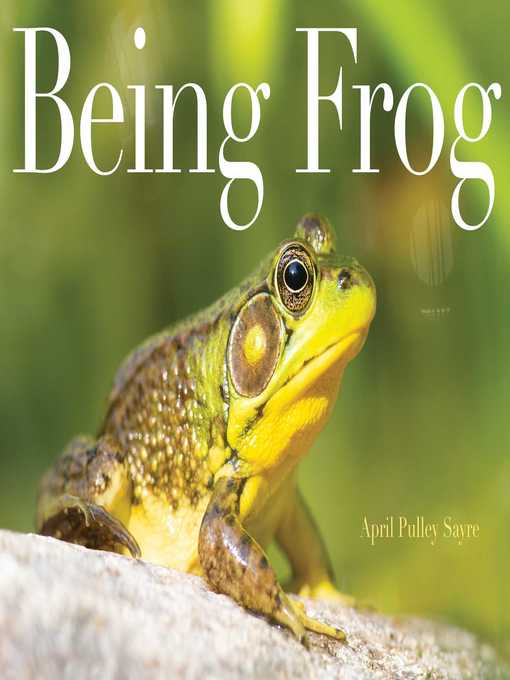
Being Frog
فرمت کتاب
ebook
تاریخ انتشار
2020
Lexile Score
290
Reading Level
0-1
ATOS
1.2
Interest Level
K-3(LG)
نویسنده
April Pulley Sayreناشر
Beach Lane Booksشابک
9781534428829
کتاب های مرتبط
- اطلاعات
- نقد و بررسی
- دیدگاه کاربران
نقد و بررسی

October 15, 2019
This photo essay about the eponymous amphibian includes simple rhyming sentences both informative and appreciative. The first verso states boldly: "A frog / is a being. / It is watching. / It is seeing." The photograph across the gutter presents a close-up view of a green frog's face against a blurry, muted, outdoor background. The simple verses scan well throughout. Many of the sentences use "It" to refer to the frog whose life is being studied; just one "It" has a different antecedent, which throws a slight curve during initial reading. However, this small book of relatively few words manages to say a lot. Some pages give readers a rudimentary understanding of a frog's daily life and the life cycle of a frog. Others provide gentle reminders that these are sentient creatures whose lives are only partly understood by human beings. ("Does it ponder? / We don't yet know.") The excellent photography--with sharp images that join the text in provoking humor, interest, and reverence--attests to the author's note about spending a good deal of time observing frogs at a nearby pond. The author's note itself is lovely: While offering fascinating details about her own encounters with specific frogs, it also clarifies for young readers the difference between scientific and anecdotal research--and the value in both. The youngest readers will love the photographs and rhymes; slightly older children will also appreciate the author's note. Sound tadpole philosophy. (resources) (Informational picture book. 3-6)
COPYRIGHT(2019) Kirkus Reviews, ALL RIGHTS RESERVED.

December 1, 2019
PreS-Gr 3-A frog is a living being with habits and needs. The author's spare verse walks the reader through detailed photographs of a frog's typical day, including lots of waiting, swimming, and leaping. The text does a good job of evoking and contextualizing a frog's life without overwhelming readers with excessive information by using simple rhymes. Notable omissions, including a frog's diet, make this best for a very young audience rather than for research projects. Detailed photographs show frogs in their natural habitats and reveal the textures and tones of a pond, a plant, or a rock. The photos could encourage crowd participation in a storytime setting; the storyteller could ask very young children to find the frog on the page, list the plants or environments they see, or describe what the frog is doing (swimming, sitting, climbing). While resources for further exploration are limited to three websites, the inclusion of a resource for recorded frog songs and calls is a unique feature. VERDICT A beautifully photographed nonfiction book suitable for read-aloud.-Savannah Kitchens, Parnell Memorial Library, Montevallo, AL
Copyright 2019 School Library Journal, LLC Used with permission.

Starred review from December 9, 2019
Focused on frogs’ essential frog-ness rather than anthropomorphized interpretations of amphibian life, Sayre uses rich photographs and evocative language to explore how frogs might understand and experience their environments. Spare, poetic language with a loose sense of rhyme is paired with photographs documenting frogs at rest and in motion: “A frog must hunt./ It scans. It spies./ It crawls. It lunges./ It fails. Retries.” Sayre’s close-up photos have a crystalline lucidity, immersing readers in the animals’ lush, watery world. Simple questions (“Does frog time fly? Or trail, snail-slow?”) invite readers to consider how the world may look and feel to a frog. A robust author’s note thoughtfully explains how the book was made, as well as the differences between anecdotal evidence and scientific study. Sayre’s gentle argument—“for me a made-up frog cannot match the beauty of a real frog—a creature so alive in its pond world”—persuades. Ages 3–8.

December 1, 2019
Preschool-G Photo-illustrator and author Sayre introduces green frogs using a combination of crisp-edged photographs and succinct, rhyming text that never anthropomorphizes. Spreads are composed of short text sections and several related photos. For example, "First egg, / then tadpole. / Two legs. Four. / A tiny froglet / climbed ashore" is accompanied by five color photographs, each depicting a developmental stage. She emphasizes that these creatures are alive ("A frog / is a being"), neither human nor toy, and resists the urge to assume intent or motive ("Does it ponder? / We don't yet know"). An informative author's note describes her creative process (photographing four hours per day for several months), explains how to tell males and females apart (a male green frog has a yellow throat and an ear disc larger than its eye), and recounts some personal experiences with the frogs she observed. While Sayre doesn't include typical report factoids (body parts, habitat, size), the accessible text and spectacular illustrations make this a stunning first look at these amphibians.(Reprinted with permission of Booklist, copyright 2019, American Library Association.)

























دیدگاه کاربران